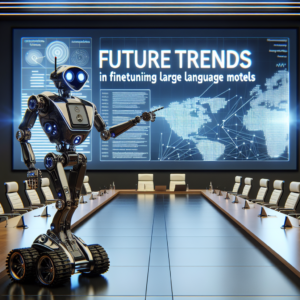1. Emerging Technologies in Language Model Training
The landscape of language model training is continuously evolving with the introduction of new technologies. These advancements are pivotal in enhancing the efficiency and effectiveness of finetuning large language models. Here, we explore some of the most promising emerging technologies that are shaping the future of this field.
Neural Architecture Search (NAS): NAS automates the design of neural networks, optimizing them for specific tasks like language modeling. This technology helps in discovering optimal network architectures that can lead to more efficient and powerful language models.
Quantum Computing: Although still in its early stages, quantum computing promises to revolutionize various aspects of computing, including the training of large language models. Quantum algorithms have the potential to process information at speeds unattainable by classical computers, potentially reducing the time required for model training and finetuning.
Energy-Efficient Hardware: As the size of language models grows, so does their energy consumption. Emerging hardware technologies focused on energy efficiency are critical. These include specialized AI chips and neuromorphic computing devices that mimic the human brain’s neural architecture, offering faster processing times and reduced power consumption.
These technologies not only promise to enhance the capabilities of large language models but also aim to make their development more sustainable and cost-effective. As we continue to push the boundaries of what’s possible with AI, these innovations play a crucial role in the ongoing evolution of language model training.
By integrating these technologies, developers can expect to see not only improvements in the performance of their models but also enhancements in how these models are trained, leading to advancements in both predictive accuracy and operational efficiency.
2. The Role of Transfer Learning in Model Evolution
Transfer learning has become a cornerstone in the evolution of large language models. This technique leverages knowledge gained from one task to improve performance on another, often related, task. Here’s how transfer learning is pivotal in finetuning these complex models:
Accelerating Development: Transfer learning significantly reduces the time and resources required to develop new models. By reusing pre-trained components, developers can achieve high levels of performance with fewer data and less computational power.
Enhancing Model Generalization: Models trained with transfer learning tend to generalize better to new tasks. This is because they start with a broad understanding of language from the pre-trained base, which is then refined for specific applications.
Enabling Smaller Data Footprints: For many tasks, gathering a large labeled dataset is impractical. Transfer learning allows models to perform well even with limited data, making advanced AI more accessible across different industries.
These benefits are not just theoretical but are evidenced in numerous applications, from natural language processing tasks like sentiment analysis to more complex challenges like automated translation. Transfer learning not only enhances the capabilities of language models but also democratizes AI technology, enabling smaller players to compete with tech giants.
As we look to the future, the role of transfer learning in language model training is expected to grow, driven by continuous advancements in AI research and an increasing emphasis on efficient and ethical AI development.
2.1. Understanding Transfer Learning
Transfer learning is a powerful technique in machine learning, especially beneficial in the context of large language models. This section delves into the fundamentals of transfer learning, highlighting its significance and mechanics.
Core Concept: At its core, transfer learning involves taking a model developed for one task and repurposing it for another related task. This approach is particularly effective in natural language processing (NLP) where large datasets are often required to train models from scratch.
How It Works: Initially, a base model is trained on a large dataset, such as texts from books, articles, or websites. This model learns a wide array of language features and patterns. Subsequently, this pre-trained model is fine-tuned with a smaller, task-specific dataset. This fine-tuning adjusts the model’s weights slightly to specialize in tasks like sentiment analysis, translation, or summarization.
Key advantages of transfer learning include:
- Efficiency: Reduces training time as the model has already learned significant features from the extensive initial training.
- Lower Data Requirements: Makes it feasible to achieve high accuracy with considerably smaller datasets.
- Improved Performance: Often results in better performance on specialized tasks due to the broad learning foundation.
Understanding these aspects of transfer learning is crucial for anyone involved in the development of AI and NLP technologies. It not only saves resources but also opens up possibilities for smaller projects to leverage state-of-the-art models effectively.
2.2. Case Studies: Successful Transfer Learning Applications
Transfer learning has been instrumental in achieving remarkable successes across various domains. This section highlights key case studies that demonstrate the practical applications and effectiveness of transfer learning in enhancing large language models.
Language Translation: One of the most notable applications is in the field of language translation. For instance, models like Google’s BERT have been adapted to improve translation accuracy significantly. By fine-tuning on specific language pairs, these models achieve superior fluency and context understanding compared to traditional methods.
Sentiment Analysis: Companies use transfer learning to tailor general language models to understand customer sentiments better. This application is crucial for businesses looking to enhance customer service and product development by analyzing feedback across social media and review platforms.
Key points from these case studies include:
- Enhanced Accuracy: Models fine-tuned with transfer learning often outperform those trained from scratch, especially in complex tasks like translation.
- Cost Efficiency: Transfer learning reduces the need for extensive data collection and computation, lowering the barriers to entry for smaller entities.
- Speed of Deployment: Models can be deployed faster as they require less training time, making them ideal for rapidly changing industries.
These examples underscore the transformative impact of transfer learning on the development and finetuning of large language models. By leveraging pre-trained models, organizations can not only improve the performance of their AI systems but also achieve greater scalability and efficiency in their operations.
3. Predictive Analytics and Its Impact on Finetuning
Predictive analytics is revolutionizing the way large language models are finetuned, offering insights that drive more accurate and efficient outcomes. Here’s how predictive analytics is making a significant impact:
Enhanced Accuracy in Model Predictions: By analyzing historical data, predictive analytics helps in identifying patterns that can improve the accuracy of language models. This leads to better understanding and generation of human-like text.
Optimization of Training Processes: Predictive analytics enables model developers to foresee outcomes based on different training scenarios. This allows for optimization of resources and training strategies, reducing time and computational costs.
Proactive Error Correction: It also plays a crucial role in identifying potential errors or biases in language models before they become problematic. This proactive approach ensures models are not only efficient but also fair and unbiased.
The integration of predictive analytics into the finetuning process of large language models not only enhances their performance but also ensures they are more aligned with real-world applications. As predictive tools evolve, their role in developing sophisticated, reliable, and ethical AI systems will undoubtedly expand, marking a significant trend in the future of AI development.
4. Ethical Considerations in Advanced Language Models
The integration of large language models into various sectors raises significant ethical considerations. These concerns are crucial for maintaining trust and accountability in AI deployments. Here, we explore the key ethical issues associated with advanced language models.
Data Bias and Fairness: One of the primary concerns is the potential for inheriting biases from training data. This can lead to unfair outcomes in applications like hiring, lending, and law enforcement. Ensuring fairness involves rigorous testing and data curation to identify and mitigate biases.
Privacy Concerns: As language models often train on vast amounts of data, including potentially sensitive information, maintaining user privacy is paramount. Techniques like differential privacy are employed to train models without compromising individual data security.
Key points to consider:
- Transparency: Developers must ensure that the workings of language models are understandable to users, especially when decisions impact them directly.
- Accountability: Clear guidelines and frameworks should be established to determine who is responsible for the outcomes produced by language models.
- Regulatory Compliance: Adhering to international standards and regulations is essential to ensure ethical usage of AI technologies.
Addressing these ethical considerations is not just about preventing harm but also about enhancing the societal benefits of large language models. By prioritizing ethical practices, developers and companies can foster greater innovation while ensuring equity and respect for user privacy.
5. The Future of AI and Language Model Interoperability
The future of AI heavily relies on the interoperability of large language models across various platforms and applications. This section explores how enhancing interoperability is crucial for the next generation of AI systems.
Standardization of Model Formats: A key step towards interoperability is the standardization of model formats. This allows models to be easily shared and integrated across different systems without compatibility issues.
Unified APIs: Developing unified APIs that can interact with multiple language models regardless of their underlying architecture will streamline integration and usage. This approach reduces the complexity and cost of deploying AI solutions in diverse environments.
Key points to consider:
- Collaborative Frameworks: Encouraging collaboration among tech companies to develop open-source frameworks that support model interoperability.
- Regulatory Influence: Governments and international bodies could play a role in setting interoperability standards to ensure a level playing field.
By focusing on these aspects, the AI community can ensure that language models not only advance in capability but also in their ability to function seamlessly across various sectors and platforms. This will be instrumental in realizing the full potential of AI applications in the real world.
6. Industry Adaptations to New Language Model Capabilities
As large language models evolve, industries are rapidly adapting to leverage these advanced technologies. This section highlights how various sectors are integrating new language model capabilities to enhance their operations and services.
Healthcare: In healthcare, language models are being used to improve patient care through more accurate and faster diagnosis. They also assist in personalizing treatment plans by analyzing patient data and medical literature.
Finance: The finance sector utilizes language models for risk assessment, fraud detection, and customer service automation. These models analyze large volumes of financial data to provide insights that were previously unattainable.
Key points to consider:
- Customer Support: AI-driven chatbots and virtual assistants, powered by sophisticated language models, are becoming the frontline of customer interaction across many industries.
- Legal and Compliance: Language models help in automating the review of legal documents and ensure compliance with regulations by quickly processing and interpreting complex legal language.
These adaptations not only demonstrate the versatility of large language models but also underscore the transformative impact they have across different fields. By embracing these capabilities, industries can achieve significant efficiency gains, cost reductions, and improvements in service delivery.



